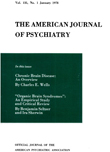An interpersonal approach to hysteria
Abstract
The author defines hysteria in terms of specific observable classes of interpersonal behaviors and examines the impact of these behaviors on the receiver. The hysteric communicates frailty and helplessness, thus structuring the interpersonal environment to ensure attention and inhibit aggression. The development of these roles is shown in histories of female hysterics, who were selectively reinforced for frailty, seductiveness, and passivity as children. The major classes of symptoms shown by adult hysterics--conversion symptoms and dissociative reactions--reflect these interpersonal roles. The author concludes that hysteria is a relatively specific interpersonal style that results from cultural, social, and interpersonal influences.
Access content
To read the fulltext, please use one of the options below to sign in or purchase access.- Personal login
- Institutional Login
- Sign in via OpenAthens
- Register for access
-
Please login/register if you wish to pair your device and check access availability.
Not a subscriber?
PsychiatryOnline subscription options offer access to the DSM-5 library, books, journals, CME, and patient resources. This all-in-one virtual library provides psychiatrists and mental health professionals with key resources for diagnosis, treatment, research, and professional development.
Need more help? PsychiatryOnline Customer Service may be reached by emailing [email protected] or by calling 800-368-5777 (in the U.S.) or 703-907-7322 (outside the U.S.).



